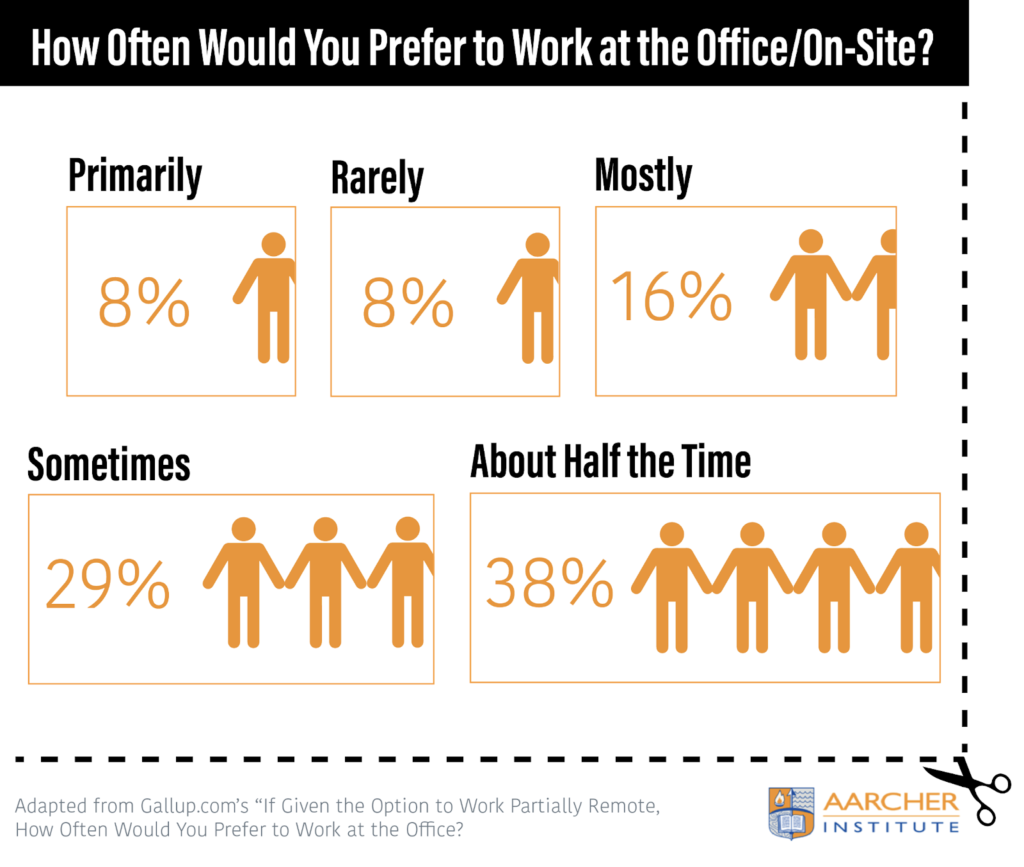This is Part 1 of 4 in the series “Hybrid Work in the EHS Industry.”
The statistics for hybrid work don’t lie. According to a recent Gallup poll, 60% of employees worked on-site for their job in 2019. By 2022, only 23% do. Only nine out of 100 employees say they would prefer working completely on-site for their jobs.

Additionally, a McKinsey American Opportunity Report stated that approximately 90% of 25,000 Americans said they would take a hybrid job if it was offered to them.
Ultimately, a resounding majority of employees unquestionably prefer hybrid jobs over traditional on-site jobs. As Gallup concluded in its poll results, “Remote work is here to stay, and hybrid work is the future for many remote-capable employees.”
Why is hybrid work on everyone’s mind?
- Employees List Hybrid Flexibility as a Reason for Job Happiness
- Employers Think Hybrid Employees Can be a Headache
- Hybrid Work is Not Going Away

Employees List Hybrid Flexibility as a Reason for Job Happiness
It’s important to avoid discounting that having flexibility around where one works can help improve employee happiness, personal time, and even finances.
According to a 2022 Pew Research Center survey, the top reasons employees left jobs during The Great Resignation were:
- Low pay (63%)
- No opportunity for advancement (63%)
- Disrespectful work conditions (57%)
- Child care issues (48%)
- Not enough flexibility in hours (45%)
Of those who quit their job in 2021 and found new work, 50% cited having a flexible workplace as a benefit of their new job.
In a 2022 study conducted by Cisco across 28,000 full-time employees across 27 markets, hybrid work helped work-life balance improve, mostly due to reducing the time to commute to and from work. It also reduced time-wasting activities experienced at work such as water-cooler chats. The reduction in time-chewers gave workers anywhere from four to eight extra hours of personal time per week.
In Cisco’s report, which spanned across generations, gender, and seniority, most employees reported seeing improvements in:
- Work performance
- Well-being
- Work-life balance
- Relationships
- Personal confidence
Working from home more also helped employees save money, from a 5% to 15% increase in savings. With less money spent on fuel, eating out, and work clothes, these long-term savings made an impact on employees -– even to the extent of staying at a job that offered hybrid work versus taking a new job that did not.
Employers Think Hybrid Employees Can be a Headache
Employers are concerned about having their employees work from home because of various reasons one would expect … and not expect. These reasons include the energy to put together an effective hybrid experience, navigate office politics, and stay in compliance with tax complexities.
In a recent survey conducted by Google Workspace, the top hybrid work issues reported by employers were:
- Keeping hybrid workers productive
- Ensuring the hybrid experience is equitable
- Making sure on-site employees are collaborative with hybrid employees
Office politics are more complicated, too. Researchers from MIT reported hybrid workers may face the brunt of not having a constant presence at the office. This can create the effect of poor performance reviews, fewer promotions, and smaller raises in comparison to on-site workers.
Also, out-of-state employees in a hybrid work model can cause increased taxes for employers. An employer is forced to establish a nexus, where the company creates a business presence that pays taxes in the employee’s home state. The nexus rule was waived during the peak of COVID-19 but is back in effect now. Additionally, nonexempt employees who are using a hybrid schedule can complicate employers’ workload because they have to ensure the company is in compliance with state and federal wage laws.
Hybrid Work is Not Going Away
After publishing its report about hybrid work, Cisco concluded: “Leaders must acknowledge that a point of no return has been reached, and there must be deeper and more concerted investments in culture, communications, technology, workplace policies, and infrastructure to thrive in the new hybrid working future.”
In the EHS industry, a 2022 Antea Group survey showed that 29% of EHS companies stated that more than half of their workforce will most likely work from home permanently. Not a large number when compared to the state of the country at large.
If you are an EHS decision-maker who is tempted to ignore employees who want hybrid work, here’s something to think about. According to Gallup’s research, if an employee is forced to work on-site but would have preferred a hybrid option, they:
- are not as engaged
- have decreased well-being
- experience more burnout
- are likely looking for another job
Aarcher will continue to report on the state of the hybrid job market in the months to come.
- Part 2: Making the Case for Hybrid Work in the EHS Industry
- Part 3: Making the Case Against Hybrid Work in the EHS Industry
- Part 4: How to Create an Optimum Hybrid Model in the EHS Industry
Resources:
Americans are Embracing Flexible Work—and They Want More of It, Andre Dua, Kweilin Ellingrud, Phil Kirschner, Adrian Kwok, Ryan Luby, Rob Palter, and Sarah Pemberton, McKinsey.com.
Back to Office? Stay Remote? Go Hybrid?, Christina Pazzanese, Harvard.edu.
Be Aware of Legal Challenges with Hybrid Work, Leah Shepherd, SHRM.org.
Employees are Ready for Hybrid Work, are You? Cisco.com.
How EHS Leaders Can Plan for the Reality of WFH and Hybrid Workplaces, AnteaGroup.com.
Instead of Hybrid, Remote or In-Office Work Styles, This May Be a Better Option, Jack Kelly, Forbes.com.
The Future of EHS, Bill Pennington, EHSToday.com.
The Future of Hybrid Work: 5 Key Questions Answered With Data, Ben Wigert, Gallup.com.
Majority of Workers Who Quit a Job in 2021 Cite Low Pay, No Opportunities for Advancement, Feeling Disrespected, Kim Parker and Juliana Menasce Horowitz, PewResearch.org.
Navigating Hybrid Work: A Google Workspace Handbook, Google.com.